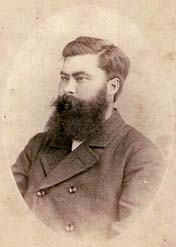
2 March 2011
A Train That Never Came
to Georgian Bay

|
Duncan Fraser Macdonald, Parry Sound pioneer and intrepid woodsman - Date unknown Archives
of Ontario F1023 Acc. 12318. |

Lake Nipissing Ontario - In pioneer times, every settler's dream was that a railway would follow
in his wagon tracks.
Wasn't a life of ease and enlightenment guaranteed to arrive with the first train?
Once, before it was abruptly snatched away, a proposed east-west artery of steel was expected to lay open northern Parry Sound District to civilization.
This was during the planning stages of the storied Canadian Pacific Railway line that bound British Columbia to the rest of Canada.
For a while, it was projected to pass south of Lake Nipissing and terminate at the mouth of the French River, where steamboats would bridge the gap to Thunder
Bay.
The proposed "Georgian Bay Branch" of the CPR was no mere line drawn on a map.
Before it was abandoned in favour of a north-of-Superior route, part of the right-of-way had already been cleared.
Before that, surveyors had spent months blazing the way, and ahead of the surveyors, others had tramped the woods searching for a suitable route.
Parry Sound pioneer Duncan F. Macdonald was one of those intrepid woodsmen who marched ahead finding the way.
On Monday, 5 Dec 1875, Macdonald struck off up the Nipissing Road from Rosseau by dog team to join a 33-man survey crew camped in the vicinity of Commanda.
Headed by engineer-in-chief William Murdoch, the crew was charged with locating a railway route from that point eastward into what is now northwestern
Algonquin Park (a second crew worked west of the Nipissing Road).
In his pocket diary, Macdonald recorded the names of crewmembers and their positions, from chief engineer down through instrument handlers, axemen, cooks,
packers, and dog drivers.
Macdonald stands out as the lone "explorer" in the gang.
The tools of his trade were the snowshoes on which he would trudge uncounted miles probing gullies and climbing to hilltop viewpoints in search of the line of
least resistance for Canadian Pacific locomotives.
Work Preparations
Preparations for the winter's work took up most of December.
Macdonald helped cut out a dogsled trail eastward around Ruth Lake, then returned south to help out around the expedition's base depot near Magnetawan.
His diary entries reveal how the depot was supplied from "outside," and how outlying camps were provisioned.
On 13 Dec 1875, he noted that "Harvie's teams" had arrived from the south with loads, and that "boys [came] in with dog trains from both
camps." (Gravenhurst-based John Harvie was early Muskoka-Parry Sound's leading overland freight and passenger carrier. He had scores of teams cadging for
settlers on the Muskoka and Nipissing colonization roads, railway construction camps, and lumber companies.)
21 Dec 1875 found Macdonald "fixing pack straps and outfit for the explorations," and on Christmas Day he "spent all day in camp and had a good
time in general till midnight."
But the next day saw a return to grim reality, when Macdonald noted "a grayback riot in camp."
The consequences of unwashed men living in close quarters had reared its ugly head: the camp was lousy.
At last, on 28 Dec 1875, Macdonald commenced the work he was hired for.
Leaving camp three miles east of the Nipissing Road, he and a companion, Kommandah (likely a native from Lake Nipissing), "started exploring. Struck east
and brought up against high mountains. No (railway) route so far. Camped on the Bobcaygeon Line (the future east boundary of Parry Sound District)."
New Year's Day was spent in camp resting "after yesterday's tramp [over] rough country, broken ridges, swamps, creeks running over, and wet. Soft
travelling."
Snowshoeing in wet snow is hard on both man and snowshoes, and in the weeks to come Macdonald would devote considerable time to mending his snowshoes.
Macdonald Diary
Each evening, Macdonald condensed the events of a fatiguing day into a few terse sentences.
His diary entries of 3 and 4 Jan 1876 typify the hardships encountered in locating a railway line through a rugged, unexplored wilderness.
January 3: (John) Galbraith (head surveyor) and I out exploring. Travelled east to the Bobcaygeon Line and turned to the sou-west and then west. Camped
west of the "Big Marsh" without blankets. Took us nearly all night to dry our clothes. I shot a partridge in the morning.
January 4: Left our camp and travelled nor-west to the G.B.B. camp through a rough and broken country. Things looking blue. Backing up and butting up
against hills and everything to stop us.
Here we leave Duncan Macdonald roughing it in the woods in the western foothills of Algonquin Park. My next column will take up the story again.
John Macfie.

|


